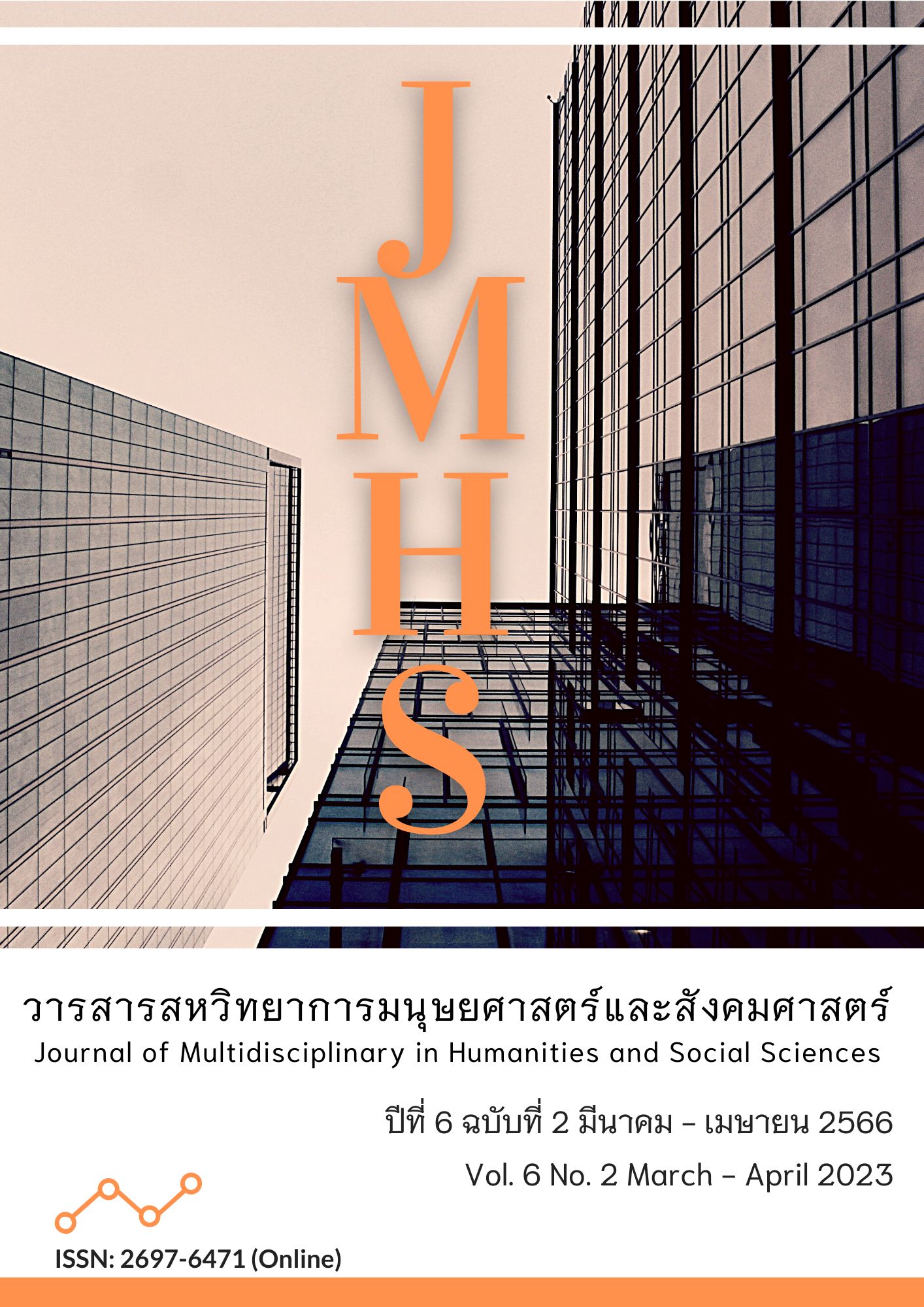การวิเคราะห์ปัจจัยที่ส่งผลต่อการเรียนการสอนคณิตศาสตร์ในศตวรรษที่ 21 ของครูโรงเรียนในสังกัดสำนักงานเขตพื้นที่การศึกษามัธยมศึกษาลพบุรี
Main Article Content
บทคัดย่อ
บทความนี้มีวัตถุประสงค์เพื่อ 1) วิเคราะห์ปัจจัยที่ส่งผลต่อการเรียนการสอนคณิตศาสตร์ในศตวรรษที่ 21 ของครูโรงเรียนในสังกัดสำนักงานเขตพื้นที่การศึกษามัธยมศึกษาลพบุรี และ 2) เปรียบเทียบแต่ละปัจจัยที่ส่งผลต่อการเรียนการสอนคณิตศาสตร์ในศตวรรษที่ 21 ของครูคณิตศาสตร์กับลักษณะของครูคณิตศาสตร์ ที่แตกต่างกันซึ่งเป็นการวิจัยเชิงสำรวจ โดยใช้แนวคิดเกี่ยวกับการจัดการเรียนการสอนในศตวรรษที่ 21 และทฤษฎีความรู้ในการบูรณาการระหว่างเทคโนโลยี วิธีการสอน และเนื้อหาสาระ เป็นกรอบการวิจัย กลุ่มตัวอย่างเป็นครูคณิตศาสตร์ระดับมัธยมศึกษาจำนวน 60 คน โรงเรียนในสังกัดสำนักงานเขตพื้นที่การศึกษามัธยมศึกษาลพบุรี (จากประชากรทั้งหมดจำนวน 129 คน) ภาคเรียนที่ 1 ปีการศึกษา 2565 ที่ได้จากการสุ่มกลุ่มตัวอย่างแบบหลายขั้นตอน สำหรับเครื่องมือที่ใช้ในการวิจัยเป็นแบบสอบถามเกี่ยวกับปัจจัยที่ส่งผลต่อการเรียนการสอนคณิตศาสตร์ในศตวรรษที่ 21 ของครูคณิตศาสตร์ คณะผู้วิจัยวิเคราะห์ข้อมูลโดยใช้ค่าร้อยละ ค่าเฉลี่ย ส่วนเบี่ยงมาตรฐาน การวิเคราะห์องค์ประกอบ และการทดสอบค่าที ผลการวิจัยพบว่า 1. ปัจจัยที่ส่งผลต่อการเรียนการสอนคณิตศาสตร์ในศตวรรษที่ 21 ของครูโรงเรียนในสังกัดสำนักงานเขตพื้นที่การศึกษามัธยม ศึกษาลพบุรี ประกอบด้วย 7 ปัจจัย ได้แก่ 1) การสนับสนุนการใช้เทคโนโลยีจากโรงเรียน 2) ความต้องการใช้เทคโนโลยีประกอบการสอน 3) ความสามารถในการใช้เทคโนโลยีพื้นฐาน 4) ความสามารถในการใช้เทคโนโลยีเฉพาะด้าน 5) ความรู้ด้านเนื้อหา 6) วิธีการสอนที่หลากหลาย และ 7) วิธีการสอนแบบบรรยาย และ 2. ครูที่มีอายุแตกต่างกัน มีปัจจัยความสามารถในการใช้เทคโนโลยีเฉพาะด้านแตกต่างกัน ที่ระดับนัยสำคัญทางสถิติ .01
Article Details

อนุญาตภายใต้เงื่อนไข Creative Commons Attribution-NonCommercial-NoDerivatives 4.0 International License.
ทัศนะและความคิดเห็นที่ปรากฏในวารสาร ถือเป็นความรับผิดชอบของผู้เขียนบทความนั้น และไม่ถือเป็นทัศนะและความรับผิดชอบของกองบรรณาธิการ
เอกสารอ้างอิง
ณัฐภรณ์ ศิริธร, มณีญา สุราช และ นครชัย ชาญอุไร. (2563). ปัจจัยที่ส่งผลต่อประสิทธิภาพการสอนของครูผู้สอนกลุ่มสาระการเรียนรู้คณิตศาสตร์ สังกัดสำนักงานเขตพื้นที่การศึกษาประถมศึกษาหนองคาย เขต 2. วารสารวิชาการมหาวิทยาลัยราชภัฏอุดรธานี, 8(2), 162-177.
ทิศนา แขมมณี. (2559). ศาสตร์การสอน. (ครั้งที่ 2). กรุงเทพฯ: จุฬาลงกรณ์มหาวิทยาลัย.
พรรณภัทร แซ่โท้ว. (2562). ปัจจัยที่ส่งผลต่อการเรียนวิชาคณิตศาสตร์ของนักศึกษาวิทยาลัยดุสิตธานี พัทยา. วารสารวิทยาลัยดุสิตธานี, 13(2), 294-306.
มุกดามณี ศรีพงษ์เพริศ. (2561). ปัจจัยคัดสรรที่ส่งผลต่อประสิทธิภาพการจัดการเรียนรู้ในศตวรรษที่ 21 ของครูประถมศึกษา จังหวัดปทุมธานี(วิทยานิพนธ์ปริญญามหาบัณฑิต). มหาวิทยาลัยเทคโนโลยีราชมงคลธัญบุรี.
โรสนี จริยะมาการ. (2561). ปัจจัยที่มีอิทธิพลต่อผลสัมฤทธิ์ทางการเรียนวิชาคณิตศาสตร์ของนักศึกษามหาวิทยาลัย นราธิวาสราชนครินทร์: การวิเคราะห์พหุระดับ. วารสารมหาวิทยาลัย นราธิวาส สาขามนุษยศาสตร์และสังคมศาสตร์, 5(2), 26-40.
ล้วน สายยศ และ อังคณา สายยศ. (2543). เทคนิคการวัดผลการเรียนรู้. กรุงเทพฯ: สุวีริยาสาส์น.
วัชรี กาญจน์กีรติ. (2554). การจัดการเรียนรู้คณิตศาสตร์. เพชรบุรี: มหาวิทยาลัยเพชรบุรี.
วิมล มิระสิงห์. (2552). ปัจจัยบางประการที่ส่งผลต่อการใช้เทคโนโลยีสารสนเทศเพื่อเสริมการเรียนรู้ในชั้นเรียนของนักเรียนระดับช่วงชั้นที่ 2 โรงเรียนในสังกัดสำนักงานคณะกรรมการศึกษาขั้นพื้นฐาน เขตพื้นที่การศึกษากรุงเทพมหานคร เขต 2(ปริญญาการศึกษามหาบัณฑิต). มหาวิทยาลัยศรีนครินทรวิโรฒ.
สถาบันส่งเสริมการสอนวิทยาศาสตร์และเทคโนโลยี. (2562). คู่มือการใช้หลักสูตรรายวิชาพื้นฐานวิทยาศาสตร์ ตามหลักสูตรแกนกลางการศึกษาขั้นฐาน พ.ศ. 2551 (ฉบับปรับปรุง พ.ศ. 2560) สาระเทคโนโลยี (วิทยาการคำนวณ) ระดับประถมศึกษาและมัธยมศึกษา. (พิมพ์ครั้งที่ 2). กรุงเทพฯ: กระทรวงศึกษาธิการ.
สำนักบริหารงานการมัธยมศึกษาตอนปลาย. (2559, 8 กันยายน). แนวทางจัดการเรียนรู้ในศตวรรษที่ 21. สืบค้นเมื่อ 2 กุมภาพันธ์ 2562, จาก https://webs.rmutl.ac.th/assets/upload/files.
สุชาติ คุ้มมะณี. (2562). Basic Python Coding เรียนง่ายเป็นเร็ว. นนทบุรี: บริษัท ไอดีซี พรีเมียร์ จำกัด.
สุภัทรา เกิดมงคล. (2550). กิจกรรมการเรียนการสอนเรื่องสมบัติของวงกลม โดยใช้ซอฟต์แวร์เรขาคณิต แบบพลวัตสำหรับนักเรียนชั้นมัธยมศึกษาปีที่ 2(ปริญญาการศึกษามหาบัณฑิต). มหาวิทยาลัยศรีนครินทรวิโรฒ.
American Psychological Association & Presidential Task Force on Evidence-Based Practice. (2006). Evidence-based practice in psychology. American Psychologist, 61(1), 271–285.
Barry, P. (2017). Headfirst Python. USA: O’Reilly Media, Inc.
Churches, A. (2016, April 7). 21st century pedagogy. Retrieved July 20, 2022, from http://edorigami.edublogs.org
Dienes, Z. P. (1960). Building up mathematics. London: Hutchinson Educational LTD.
Erfjord, I. (2011). Teachers’ Initial Orchestration of Students’ Dynamic Geometry Software Use: Consequences for Students’ Opportunities to Learn Mathematics. Technology, Knowledge and Learning, 16(2), 35-54.
Kharbach, M. (2015, January 12). The 20 digital skills every 21st century teacher should have. Retrieved July 20, 2022, from http://www.educatorstechnology.com/2012/06/33-digital-skills-every-21st-century.html
Koehler, M., & Mishra, P. (2009). What is Technological Pedagogical Content Knowledge? (TPACK). Contemporary Issues in Technology and Teacher Education, 9(2), 60-70.
Koehler, M., Mishra, P., & Cain, W. (2013). What is technological pedagogical content (TPACK)?. Journal of Education, 193(2), 13-19.
March, T. (2012, June 6). 21st Century teaching skills. Retrieved July 20, 2022, from http://tommarch.com/strategies/
Martinez, A. (2022). Emergent Modelling: Using Python in an Instructional Task Sequence on Logic and Set Theory. CA: Thomson Wadsworth.
Partnership for 21st Century Skills. (2007, July 16). Framework for 21st Century Learning. Retrieved from https://www.teacherrambo.com/file.php/1/21st_century_skills.pdf
Shulman, L. (1987). Knowledge and Teaching: Foundations of the New Reform. Harvard Educational Review, 57(1), 1-23.
Vidakovic, D., Dubinsky, E., & Weller, K. (2018). Creativity and Technology in Mathematics Education APOS Theory: Use of Computer Programs to Foster Mental Constructions and Student’s Creativity. (2nd ed.). USA: Springer International Publishing AG.
Yamane, T. (1970). Statistics; An Introductory Analysis. (2nd ed.). Tokyo: John Weather Hill.


